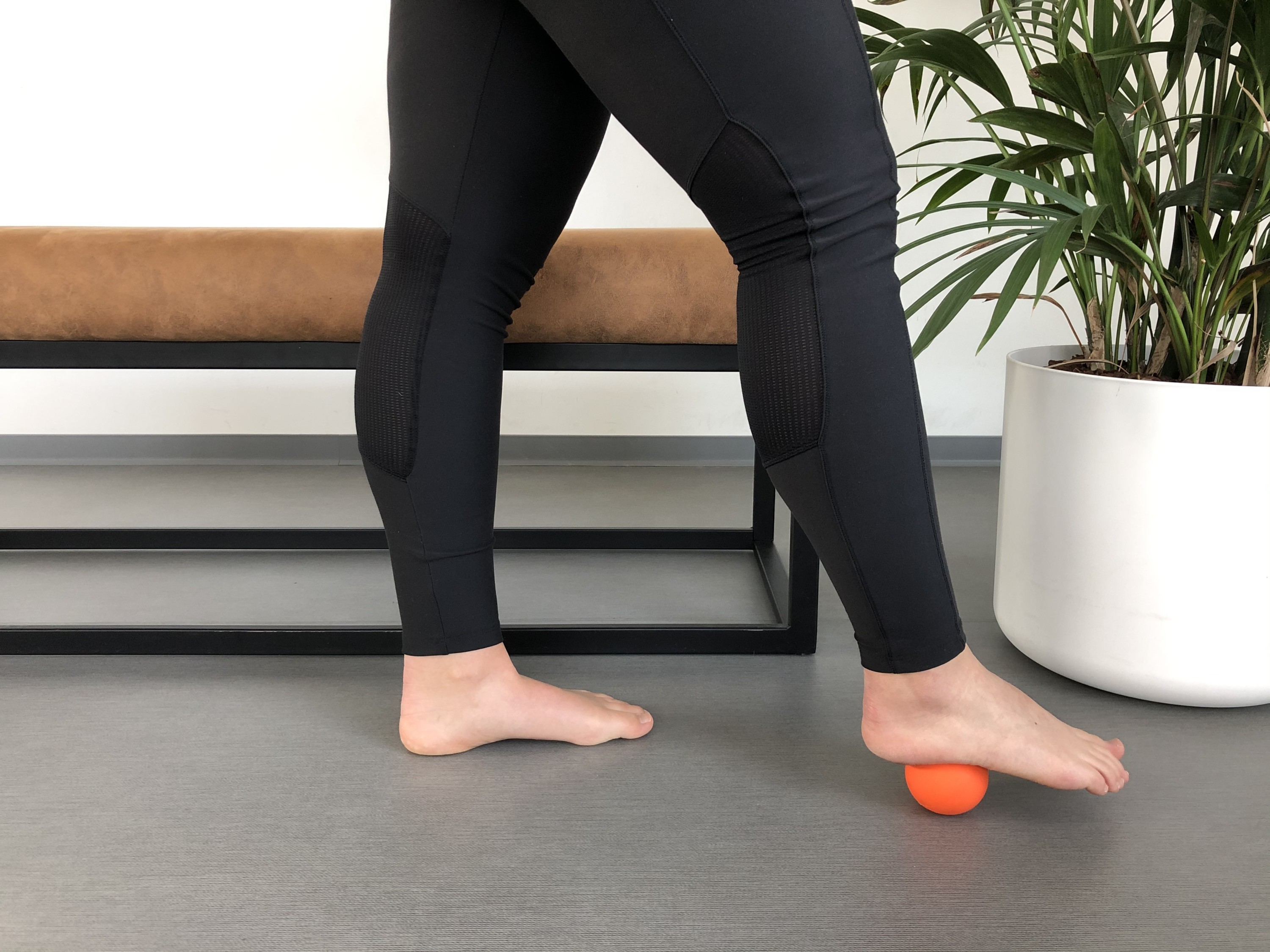
Heel spur
Heel spurs are a common complaint on the underside of the heel. The recovery time is usually long because it is difficult to get to grips with. There are various treatment options that are described further below. The most important thing is to always start with various exercises to recover.
1. Peesplaat (flexoren) rek
Ga met de voet in een deurpost of tegen een muur aan staan. Plaats de tenen tegen de muur of het kozijn. Behoudt deze positie een aantal seconden en ontspan daarna weer.
2. Gastrocnemius rek in stand
Plaats een been ruim achter het andere been. Breng de voorste knie iets naar voren toe. Zorg ervoor dat beiden hakken op de grond blijven.
3. Soleus rek in zit
Ga zitten op een stoel. Plaats de handdoek om de voet ter hoogte van de tenen. Zorg dat je een beetje op het randje van de stoel zit, zodat het been met de knie gestrekt en met de hak op de grond is. Trek, met behulp van de handdoek, de tenen naar je toe en houd de hak op de grond.
4. Bal rollen met de voet
Ga met één voet op de bal staan. Plaats de bal op de gevoelige plek. Rol vervolgens het balletje een klein stukje naar voren en naar achteren. Let op: blijf druk geven op de bal.
5. Axiale druk plantair- en dorsaalflexie (enkel)
Plaats de voeten in schrede stand. Buig de achterste knie naar voren en strek de voorste knie. Je kunt eventueel steun nemen tegen de muur.
6. Mobilisatie dorsaalflexie (enkel)
Plaats de voeten op heupbreedte en neem met de handen steun tegen een muur. Zorg dat de hakken op de grond blijven staan en breng de knieën naar voren.
Triggerpoint ball
Hard. Compact. Qualitatively.

Foamroller
Hard. Compact. Qualitatively.

The meaning of heel spur
Heel spur is a common injury affecting the bottom of the heel (calcaneus). It is difficult to treat and recovery usually takes a long time. Heel spur means there is calcification at the front of the heel (calcaneus) or in the tendon plate (plantar fasciitis) under the foot. It is called plantar fasciitis based on previous beliefs of an inflammation of the tendon plate. Research has shown this is not necessarily true and the term plantar fasciopathy (changes in quality of the tendon plate) is therefore a more suitable description.
The causes of heel spur
There are often multiple factors that contribute to the formation of a heel spur. Being overweight, poor footwear, wearing flip flops, flat feet, walking barefoot regularly and overuse are all possible contributing factors for the development of a heel spur.
The symptoms of heel spur
Symptoms are described as a sharp pain under the heel when pressing on the bottom of the heel, when starting to walk after rest or when getting out of bed in the morning. It tends to ease after a few steps. If the plantar fasciopathy is located further forward in the foot, the opposite is true. The pain is minimal after rest and starts after prolonged walking, prolonged standing or exercising. The pain may intensify after the activity. This points to a possible inflammatory response.
The treatment of heel spur
Research has been unable to indicate a single specific treatment that works to treat heel spur. There are a number of treatments that may reduce the heel pain. Shockwave Therapy (ESWT), Percutaneous Electrolysis Therapy (EPTE), strengthening exercises, stretches and myofascial techniques are options that are commonly used.
If the heel pain persists for longer than 12 weeks, shockwave therapy (ESWT) in combination with strengthening exercises for the calf muscles may be started. If there is no relief after three sessions, EPTE could be considered.
Myofascial techniques (massage techniques) and stretches are recommended alongside these procedures to improve the tendon quality and prevent calf stiffness.
Regardless of what treatment is chosen, it is important to avoid overuse of the plantar plate. On a scale of 0-10 (with 0 representing no pain at all and 10 the worst pain imaginable), the pain should not exceed level 4-5 in your daily life, during sports or after any activity.
Provided the load on the plantar plate is well managed, symptoms should disappear after 6 to 12 weeks. There are cases where recovery takes up to a year.
Other considerations to aid recovery are consulting a podiatrist, wearing a Strassburg sock or using a heel lift in the shoe.
Synonyms
Heel spurs, plantar fasciitis, heel pain, plantar plate irritation, inflammation of the heel
Advice
If you have any questions regarding the exercises, doubt if you are doing them correctly or aren’t sure they are suited for your condition, please contact your physiotherapist for support.
Attention:
Yourbody.coach offers a range of exercises. Yourbody.coach can not be held responsible if you develop injuries. Always consult your physiotherapist or specialist.